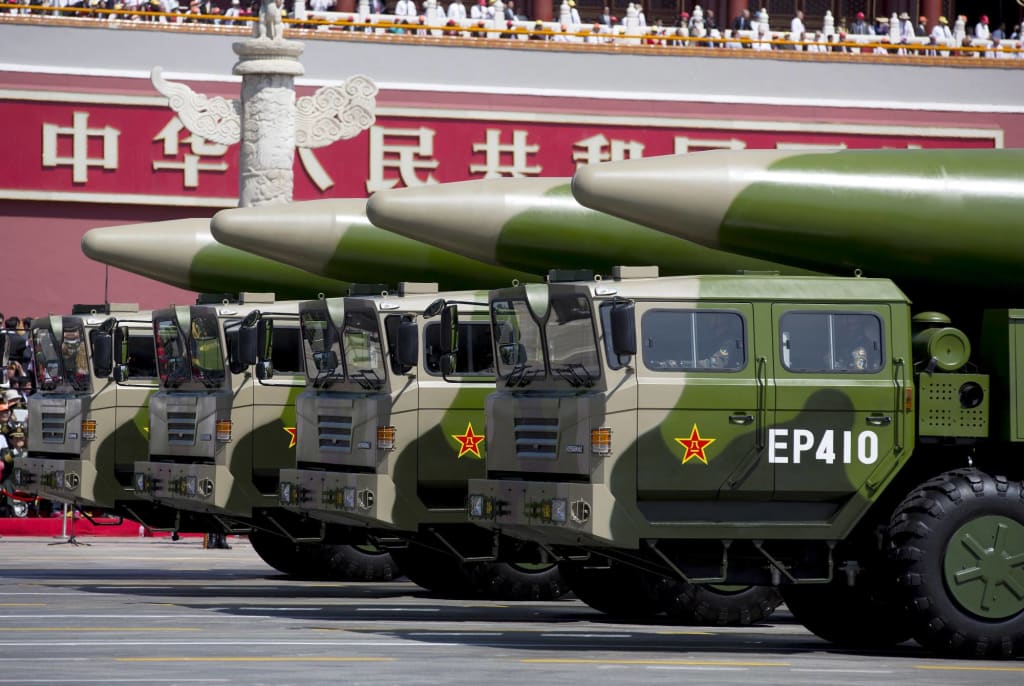
The People's Liberation Army Rocket Force (PLARF) is a strategic and tactical missile force of China. It was established in December 2015, as part of the country's military modernization drive. The PLARF is responsible for China's nuclear and conventional missile arsenal, which includes intercontinental ballistic missiles (ICBMs), submarine-launched ballistic missiles (SLBMs), medium and intermediate-range ballistic missiles, as well as cruise missiles.
The origins of China's missile program can be traced back to the 1950s when the Soviet Union provided technical assistance to China's military. However, China's missile force remained underdeveloped until the 1990s, when the country began investing heavily in its missile program. Today, the PLARF is considered one of the most advanced missile forces in the world, with a range of missiles that can reach targets across the globe.
One of the key objectives of the PLARF is to enhance China's nuclear deterrence capability. China's nuclear arsenal is estimated to comprise around 350 nuclear warheads, which is much smaller than that of the US and Russia. However, the country has been modernizing its nuclear weapons and delivery systems, including developing new ICBMs such as the DF-41, which has a range of up to 15,000 km, making it capable of striking targets anywhere in the world.
Apart from nuclear deterrence, the PLARF also plays a crucial role in China's military strategy, which is focused on winning "local wars under modern conditions." This includes the use of missiles to target enemy aircraft carriers, command and control centers, and other high-value targets, such as military bases and airfields.
In recent years, the PLARF has been actively expanding its capabilities and testing new missile systems. In 2020, China test-fired a new DF-26B missile, which is reportedly capable of carrying both conventional and nuclear warheads and has a range of up to 4,000 km. The DF-26B has been dubbed the "Guam killer" because of its ability to strike US military bases on the Pacific island.
China's missile program has also raised concerns among its neighbors, particularly in the South China Sea, where the country has territorial disputes with several countries, including the Philippines and Vietnam. In 2018, China installed missile systems on some of its artificial islands in the region, which drew sharp criticism from the US and its allies.
Despite the concerns, China has continued to invest heavily in its missile program. In 2021, the country announced plans to double its nuclear arsenal, although it also stated that it would not use nuclear weapons first in a conflict. The move has been seen as a response to the growing strategic competition with the US, which has been developing new missile systems and strengthening its military presence in the region.
The PLA Rocket Force is responsible for the strategic and tactical missile systems of China's military. It is one of the five branches of the Chinese People's Liberation Army (PLA), alongside the Ground Force, Navy, Air Force, and Strategic Support Force.
The Rocket Force has its origins in the Second Artillery Corps, which was established in 1966 during the Cultural Revolution. The Second Artillery Corps was responsible for China's nuclear and conventional missile forces. In 2015, the Second Artillery Corps was reorganized and renamed the PLA Rocket Force.
The Rocket Force is tasked with maintaining China's nuclear deterrent, which is designed to deter potential adversaries from launching a nuclear attack against China. The Rocket Force operates China's nuclear-capable ballistic missiles, which include the DF-5, DF-31, DF-41, and JL-2. These missiles can reach targets throughout the world and are capable of carrying nuclear warheads.
In addition to its nuclear deterrent mission, the Rocket Force also operates China's conventional missile forces. These include short-range ballistic missiles, medium-range ballistic missiles, and cruise missiles. The Rocket Force's conventional missiles are primarily intended for use against regional adversaries, such as Taiwan and Japan.
The Rocket Force has undergone significant modernization and expansion in recent years. China has been investing heavily in its missile forces, and the Rocket Force has been a major beneficiary of this investment. The Rocket Force has been developing new missile systems, such as the DF-26 intermediate-range ballistic missile and the DF-17 hypersonic glide vehicle.
The Rocket Force is also expanding its capabilities in space. China has been developing anti-satellite weapons, and the Rocket Force has been tasked with developing and operating these weapons. In addition, the Rocket Force is responsible for launching China's military satellites and conducting other space-related activities.
The Rocket Force has been a key part of China's military modernization efforts. China has been seeking to develop a military that is capable of defending its interests both regionally and globally. The Rocket Force's nuclear deterrent is seen as a critical component of China's national security strategy, while its conventional missile forces are seen as key to maintaining regional stability.
In recent years, the Rocket Force has become more active in international affairs. The Rocket Force has participated in international military exercises, such as the Joint Sea-2016 naval exercises with Russia. It has also been involved in diplomatic activities, such as the 2018 Strategic Stability Dialogue between the United States and China.
In conclusion, the People's Liberation Army Rocket Force is a critical component of China's military modernization and deterrence strategy. Its missile arsenal, which includes both nuclear and conventional weapons, has the capability to strike targets across the globe and poses a significant challenge to China's adversaries. As China continues to expand its missile capabilities, its neighbors and the international community will be closely watching its actions and responses.
About the Creator
Suganthan
Hi world! I am from Wonder of Asia Srilankan. Happy to write stories and History blog.
Enjoyed the story? Support the Creator.
Subscribe for free to receive all their stories in your feed. You could also pledge your support or give them a one-off tip, letting them know you appreciate their work.






Comments
There are no comments for this story
Be the first to respond and start the conversation.